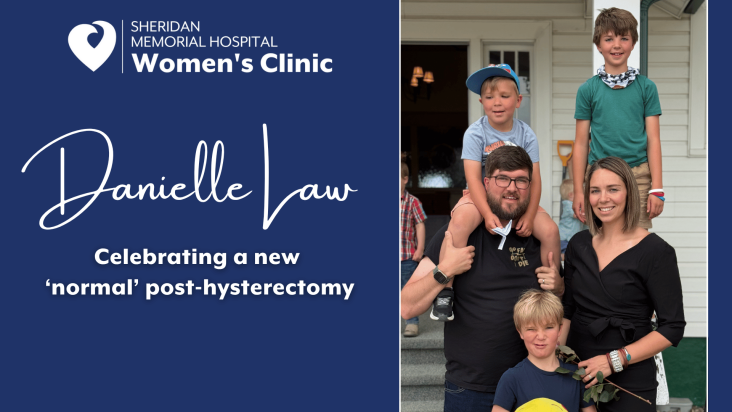When you don’t know what “normal” should look like, you learn to cope with the hand you’ve been dealt. For 35-year-old Danielle Law, that meant years of painful cramps, difficult menstrual cycles and hormones that fluctuated through extremes.
After giving birth to three boys, though, Danielle sought help figuring out what “normal” could mean for her. She worked with a functional healthcare provider who started her on supplemental hormones, but a year into that treatment Danielle knew something still wasn’t right.
“I did a lot of research,” Danielle said of that timeframe, adding that she adjusted her diet and implemented healthier habits. “I felt the best that I’ve felt in my entire life.”
About five months ago, though, her menstrual cycles returned more regularly and they were just as frustrating as they had been before she had children.
“My mom had a hysterectomy after years of dealing with endometriosis,” Danielle said. “After everything I had tried and how good I had felt, the return to that cycle of pain – I knew something was wrong. So, I called the Women’s Clinic and let them know I wanted to be checked for endometriosis.”
 Danielle said she was scheduled quickly, and sat down with Dr. Lindsay Capron to discuss her symptoms.
Danielle said she was scheduled quickly, and sat down with Dr. Lindsay Capron to discuss her symptoms.
“In all of my research, I had read horror stories about women spending years advocating for themselves and arguing with doctors about their symptoms,” Danielle said. “I didn’t have that experience at all. Dr. Capron listened to me, believed me and got to work trying to help me figure it out.”
Dr. Capron said many women are suffering with severe pain and heavy bleeding, thinking it’s normal, or worse, feeling like they are just complaining and unable to cope.
Danielle was diagnosed with adenomyosis, a condition where the tissue that normally lines the uterus grows into the muscular wall of the uterus, causing heavy menstrual bleeding and pelvic pain. It can get progressively worse with each menstrual cycle and each pregnancy.
Dr. Capron provided Danielle with several options for treatment, including ablation, hormonal treatment and hysterectomy. The hospital’s use of robotics also allows surgeons like Dr. Capron to offer excision of endometriosis as an option for treatment.
Dr. Capron noted that whether a woman is 20 or 90, the decision to pursue hysterectomy is very individualized. She and the other providers at SMH’s Women’s Clinic are available to discuss all options with patients to help find a solution that meets their needs and desires.
 “It sounded terrifying at first,” Danielle said of hysterectomy. “Dr. Capron reassured me that I didn’t have to decide right away. So I did more research – I mean these days you can research to your heart’s content.”
“It sounded terrifying at first,” Danielle said of hysterectomy. “Dr. Capron reassured me that I didn’t have to decide right away. So I did more research – I mean these days you can research to your heart’s content.”
She noted that her initial concerns centered around hormones, which she had spent so many years trying to regulate and control. Ultimately, though, Danielle opted for the hysterectomy, keeping her ovaries, knowing she was at her healthiest and excited to see an end to the pain she had endured for decades.
She was scheduled for the surgery and within two weeks Dr. Capron had utilized robotic technology at SMH to complete the procedure, leaving just four small incisions on Danielle’s abdomen and shortening the recovery time.
To celebrate the surgery, Danielle even recorded a short video of herself dancing in her hospital gown after surgery.“I wanted to show everyone that I was OK,” Danielle said.
Little did she know that one short post celebrating her choice would go viral, as women across the country empathized with her situation and celebrated that more and more options are becoming available to help women manage their menstrual cycles, pain and hormones.
“So many women were looking for information,” Danielle said of the post that went viral. “I had comments that included everything from ‘thank you’ to questions about the process, horror stories about doctors that wouldn’t listen and women saying they had done the same and never regretted it. It was wild.”
Since then, Danielle has continued sharing her story on social media, giving updates on how she’s feeling, helping women understand her journey and the options available.
A couple weeks post-surgery, Danielle had a follow-up appointment with Dr. Capron, where the WOMC provider confirmed the adenomyosis diagnosis along with endometriosis and fibroids.
“It was reassuring that I felt like I made the right decision,” Danielle said. “I feel great, almost so good that I wonder what I’m missing.”
While Danielle is still only about eight weeks post-surgery, she said she’s excited to settle into what her new “normal” will look and feel like – with less pain and an increased appreciation for her health heading into her 40s.
If you’re struggling with pain or symptoms that don’t feel “normal,” you don’t have to face it alone. The experienced team at Sheridan Memorial Hospital’s Women’s Clinic is here to listen, support, and help you find real answers. Your health matters—and so does your story. If you would like to make an appointment call or text 307.672.2522.

